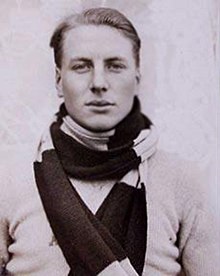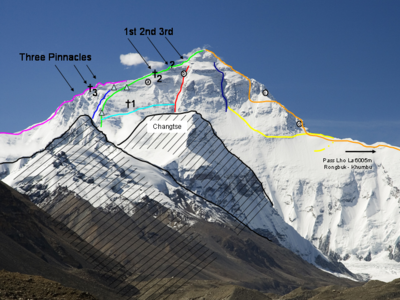Andrew Irvine
Andrew "Sandy" Comyn Irvine (born April 8, 1902 in Birkenhead , England , † June 8, 1924 on Mount Everest ) was a British mountaineer . He was killed trying to climb Mount Everest for the first time. To this day, there is speculation whether he reached the summit before he died.
biography
Andrew Irvine attended Birkenhead and Shrewsbury Schools and later moved to Merton College , Oxford . He was an avid athlete and, above all, an excellent rower. In 1923 he won the coveted trophy of the Oxford and Cambridge Boat Race with his university team .
When he was offered the opportunity to take part in a Mount Everest expedition in 1924 , the then 22-year-old had not yet completed his studies. This expedition was the second serious attempt to climb Mount Everest. Also participating in this expedition was George Mallory , who is still considered to be one of the pioneers of alpinism . He had also been part of the failed 1922 expedition two years earlier .
Andrew Irvine was not chosen as one of the most experienced alpinists, but the budding engineer and amateur photographer in England was able to draw attention to himself with his physical fitness and unconventional way of climbing on a Spitzbergen expedition. In addition, due to his studies, he knew extremely well how to use the breathing apparatus and oxygen bottles that were newly developed at the time . During the approach and also in the high camps, Irvine dealt with repairs and improvements to the then still relatively new equipment.
On November 23, 1999, the asteroid (6825) Irvine was named after him.
expedition
On the morning of June 8, 1924, Mallory and Irvine made their way to the summit from the last high camp, Camp VI (approx. 8140 m ). Pressure of time and success let the two start their attack despite the less than perfect weather. The last time they were seen by Noel Odell was probably around 1 p.m., after a long delay at a rock step.
The question of whether they made it to the summit and thus climbed Mount Everest 29 years before Tenzing Norgay and Edmund Hillary is considered a mystery and gives the world of mountaineering cause for countless debates and discussions to this day. Almost all leading alpinists speculate whether it was even possible for the two of them to cope with the ascent at the time, with the technical possibilities at the time and under the known conditions. Sir Edmund Hillary made only one statement in this regard, stating that it was a fact that in any case he was the first to come back alive from the summit of Mount Everest.
Hoped for clarification
In the 1960s - after Tibet was annexed to China - the Chinese began to develop the north ridge and climb the summit. In 1975 a ladder was attached to the so-called Second Step . This point marks what is probably the most difficult section of the route and, according to the assessment of climbing skills at the time, was perhaps an insurmountable obstacle. Several mountaineers have freely climbed the Second Step to this day, proving that the Second Step could be conquered with the resources of the time and the skills of Mallory and Irvine. Wang Hongbao from China allegedly saw the body of a climber west of the ridge. At this altitude this could only be Irvine or Mallory, because before the Chinese expedition only these two had reached this high and then disappeared on the mountain.
In 1986 and 1999 expeditions to Tibet started in the hope of z. B. to find the camera Andrew Irvines and thus to clarify the questions about the two climbers. On May 1, 1999, Mallory's corpse, well preserved by the thin air and the cold, was found at an altitude of 8,150 m. The find was a worldwide sensation. However, there was no evidence that answered essential questions and no camera was found on Mallory's body. In 2010 another expedition was started under the direction of Jochen Hemmleb to Everest to find the body of Irvine and to solve the riddle of the first ascent. However, this expedition also returned from Tibet without any new knowledge.
literature
- Jochen Hemmleb: Mount Everest crime scene: The Mallory case . 1st edition. Herbig Verlagbuchhandlung, Munich 2009, ISBN 978-3-7243-1022-8 .
- Tom Holzel, Audrey Salkeld: In the death zone. The secret of George Mallory and the first ascent of Mount Everest . 1st edition. Goldmann Verlag, Munich 1999, ISBN 978-3-442-15076-2 .
Web links
- Mallory and Irvine The Final Chapter Everest 2005: 2005 Updates. Retrieved May 21, 2012 .
- Welcome to The Mystery of Mallory and Irvine's Fate. Pete Poston, accessed May 21, 2012 .
Individual evidence
- ↑ Jochen Hemmleb: Mount Everest crime scene: The Mallory case . 1st edition. Herbig Verlagbuchhandlung, Munich 2009, ISBN 978-3-7243-1022-8 , pp. 242 .
- ↑ jochenhemmleb.com - "First on Everest" (ORF2 Universum)
| personal data | |
|---|---|
| SURNAME | Irvine, Andrew |
| ALTERNATIVE NAMES | Irvine, Andrew Comyn; Irvine, Sandy |
| BRIEF DESCRIPTION | British climber |
| DATE OF BIRTH | April 8, 1902 |
| PLACE OF BIRTH | Birkenhead , England |
| DATE OF DEATH | June 8, 1924 |
| Place of death | Mount Everest |


